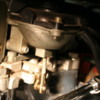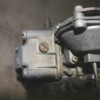I agree, at least with my Holley I believe it is the nut that adjusts the float and the screw that locks it. Operationally it is kind of hard to imagine how it is constructed with the nut (not me

) doing the adjusting, as it seems logical that the nut would only have a tightening function as we are used to a nut doing. But it is true, because I can loosen that screw slightly which then enables the nut free to spin on its own for several rotations with no grabbing functions onto the nut what so ever. I learn something new almost daily playing on these cars, and in this instance was glad I didn't blow myself up playing with gas.




